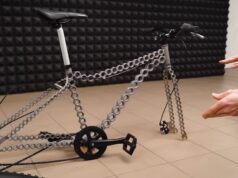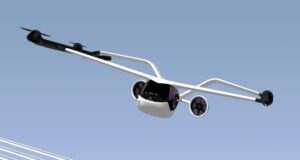A kinetic energy recovery system (KERS) is an automotive system for recovering a moving vehicle’s kinetic energy under braking. The recovered energy is stored in a reservoir for example a flywheel or high voltage batteries) for later use under acceleration.//source

image: Tom Stanton
In this video project youtube engineer Tom Stanton customizes his bicycle by attaching a flywheel system to his bicycle.The system consists of a 300 mm steel flywheel mounted in the center of the bike’s frame. It’s connected to the rear wheel via a chain and a clutch which he assembled himself using bicycle disc brake components.

image: Tom Stanton
The clutch is controlled by a handlebar lever, allowing the rider to slow the bike by charging the flywheel, or to charge the flywheel to maximum speed by pedalling hard with the clutch engaged.The system is very simple and unobtrusive. Therefore, the aesthetics of the bicycle remain intact.
Advertisement
The actual utility of the flywheel is minimal notes that even at its peak speed of 2200 RPM, the flywheel stores a small fraction of the energy content of a AA battery. Practical demonstration shows the flywheel is only able to deliver a small push to when riding the bike, too.
When the cyclist wishes to slow down, such as when they’re going down a hill or coming to a stop, they shift the transmission to maximize the flywheel-speed-to-bike-speed ratio.Once they want to accelerate or climb a hill, they do the opposite, the rider shift;s the transmission to minimize the ratio. This lets the energy stored in the flywheel drive the transmission, giving the bike and its rider a boost.









